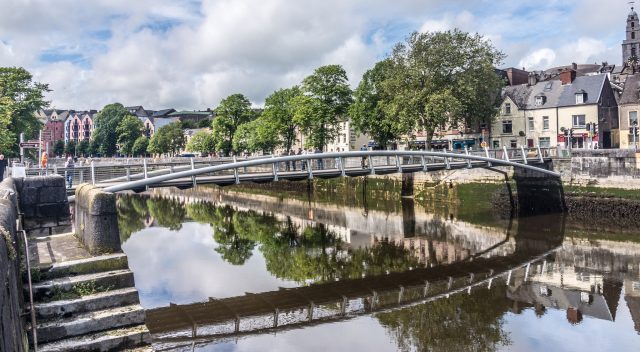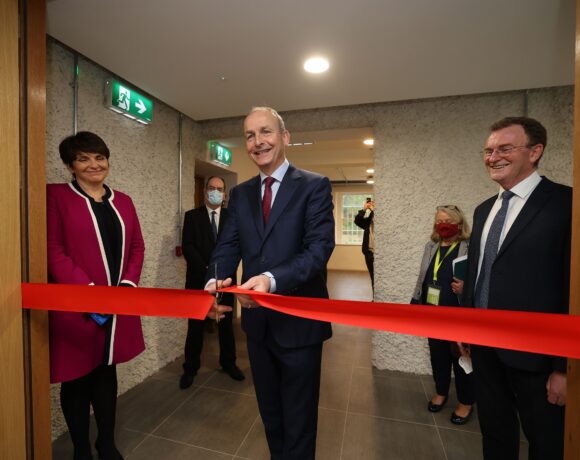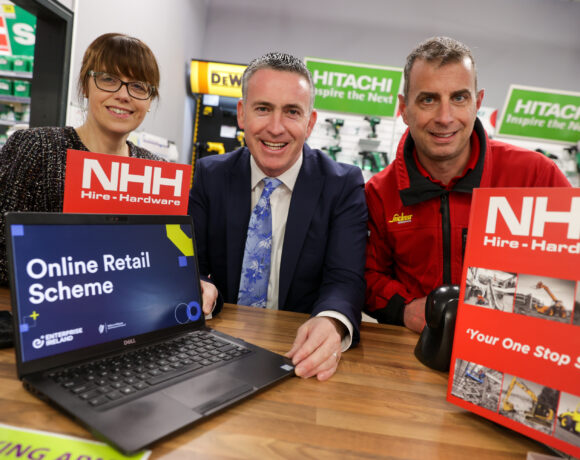Sensors, streetlights, bike lanes and phone apps are just a part of what is becoming the new urban landscape. Pauline Riordan of Dublinked and Aidan O’Riordan of Cork City Council talk to the Council Journal about Smart Cities and how technology is changing Ireland’s biggest urban centres.
There is a strange disparity between government and technology that seems out of place for the 21st century. The former, associated with bureaucracy and inefficiency, is in direct contrast to the latter, which conjures images of development, progress and efficiency. The merger of technology with governance seems like inevitability and a matter of course; much as how we have already witnessed disruptive technology upend traditional industries. However, in the case of governance it wouldn’t be a disruption. In fact, it would be the very opposite, and it has already begun in some urban centres. These cities are known as “smart cities”, and there is a good chance you might already be living in one.
As each epoch leaves its mark on a city, in the form of architecture and planning, so too will ours. The exponentially expanding digital/creative economy is already making local governments and city planners rethink how cities are being designed and built, and very soon we will see new changes to the urban environment, ushered in by waves of new technology.
This, at least, is what we are being told. But does “smart city” mark a substantial epochal shift or is just another buzz term? Some definitions seem very broad, for example Bussinessdirecory.com defines it as “a developed urban area that creates sustainable economic development and high quality of life by excelling in multiple key areas; economy, mobility, environment, people, living, and government. Excelling in these key areas can be done so through strong human capital, social capital, and/or ICT infrastructure.”
Such a broad definition sounds somewhat like a mission statement from a tech start-up that hasn’t quite decided what it actually does yet. In other words, it sounds like a nice idea but doesn’t inspire great confidence in its real world application. In order to find out more about smart cities, the Council Journal spoke to two people involved in making Ireland’s cities smarter. Pauline Riordan has worked for over 16 years in Irish local government in a number of roles including open data, smart cities, strategic design, multi stakeholder engagement and urban planning. She is the manager of the Dublinked Open Data Platform and innovation network and is also responsible for the development of a smart city policy for the Dublin region. Aidan O’Riordan is ICT Programme Manager for Cork City Council. He is leading Cork’s Growsmarter project, which is supported by the European Commission under the Horizon 2020 funding stream.


What is a smart city?
PR: There is no accepted definition of a ‘smart city’, but common elements of the smart city vision include the application of technology and exploiting the potential of big data and open data to drive efficiencies in service delivery and sustainable development.
Smart Dublin is delivering a programme that incentivises the development of new solutions to address identified city challenges. It has an emphasis on using the opportunities offered by emerging technology and public data available through Dublinked- Dublin’s open data platform.
AO’R: A smart city is a process whereby cities continuously become more attractive to people to live, work and visit. A smart city responds better to challenges, which helps it to become more resilient. However, there is no end point, and for this reason there is no one universally accepted definition of a smart city.
While there are numerous definitions of a Smart City, the UK department of Business, Innovation and Skills sums up the concept of a smart city well, as one where there is effective integration of physical, digital and human systems in the built environment to deliver a sustainable, prosperous and inclusive future for its citizens’.
Therefore, the smartness of a city is determined by how well technology is used to drive economic growth, improve public services and promote better engagement between residents, visitors and local authorities.
Is it just about technology or is there more involved?
PR: It is not just about technology – it’s about new collaborations and new ways of working. By being proactive and articulating the type of challenges we face, we can encourage the development of solutions that specifically address identified priority challenges such as the need for better mobility and transport management, response to extreme weather and flooding events, improved energy efficiency and environment, better citizen engagement and more efficient service delivery.
Pauline, can you tell me about some of the ways Dublin is adapting to become a smart city?
PR: The four Dublin local authorities are already participating in a range of smart city initiatives, however the Smart Dublin initiative will co-ordinate a regional approach and provide a central point of information for projects that cover all or most of these elements. A number of ‘smart stories’ are showcased on the Smart Dublin website, helping to promote Dublin as a smart city region.
For example, there are a number of intelligent transport solutions highlighted on the Smart Dublin website including Dublin’s traffic control centre and real time public transport information service (which feeds the signs at bus stops). There are a number of mobile and web apps that build in this real time information to help people move more easily around the city region e.g. Next Dublin Bus, Hit the Road, Google maps and other journey planners, Dublin Dashboard real time maps etc Dublinked website also highlights a number of applications by individual developers such as ‘is Dublin Busy’ and ‘Parkya’.
To encourage the development of new smart solutions to promote more cycling, Dublin has launched a ‘Small Business Innovation Research (SBIR)’ challenge with Enterprise Ireland, watch this space for announcement of successful products, services and apps that will be tested in Dublin streets over the coming months.
Aidan, how did Cork become involved in the GrowSmarter Initiative?
AO’R: As part of Cork’s initial information gathering on the smart agenda and smart city strategies, the advisory group, a cross-sectoral group of stakeholders, engaged with, amongst others, Cologne, a twinned city. As well as the political and tourism links between the sister cities, Cork and Cologne had also previously collaborated on transport projects. This engagement proved to be both a very valuable and timely exercise as Cologne were applying, along with Stockholm and Barcelona, for funding under the Horizon 2020 SCC call to deliver large scale smart demonstrator projects. It became clear during the engagement that while Cork did not have a formal smart city strategy published there was a significant amount of smart initiatives being implemented in the city and wider region. These initiatives were being delivered individually or as part of other projects by the Triple Helix of public, private and academic organisations.
The GrowSmarter lead cities recognised the potential value of including Cork as a follower city partner given its obvious commitment and invited the city to participate. The application was successful, one of the first under the H2020 SCC calls, and Cork has played an active role in the dissemination and replication planning phases of the project.
What makes Cork a good candidate for the GrowSmarter project?
AO’R: The Cork Smart Gateway concept was first discussed in 2014 when both local authorities invited key stakeholders to discuss the establishment of a regional smart initiative. The response was resoundingly positive and led to the formation of the smart gateway steering group, comprising of domain experts from Cork City Council, Cork County Council, Nimbus Research Centre and Tyndall National Institute.
During the initial development phase of the Cork Smart Gateway it was clear that the Gateway’s intensive collaboration with research entities signalled a clear opportunity for the Cork region to differentiate its Smart program. Cork also benefits from an enabling and innovative ecosystem with a strong research base, highly committed Local Authorities, engaged citizens and world leading companies in a number of sectors including engineering, ICT and design. Building upon these assets the Gateway hopes to support and promote the already large number of organisations in Cork who are working on smart solutions to improve the physical realm, from energy conservation to open data.
Cork is ideally sized to provide a ‘test bed’ for a wide range of smart innovations and applications. The compact size of the city provides the advantage of flexibility and the number of smaller urban centres across the region provides variety. The ease of collaboration that exists between various stakeholders in the region also helps in identifying and applying creative and smart solutions to solve local challenges, drive economic growth and improve the quality of life offering in Cork. These advantages help to position Cork as a progressive smart city in Ireland.
The GrowSmarter initiative will be led by three ‘lighthouse cities’, Stockholm, Cologne and Barcelona. What will Cork’s relationship be to these cities?
AO’R: The concept of the lead/follower cities is designed to support learnings and ultimately replication of the measures being demonstrated in the lighthouse cities. Cork has expressed an interest in planning the replication of 5 of the 12 smart solutions being implemented by the lead cities covering energy, mobility and integrated infrastructures. Through participation and attendance at assemblies and site visits and contributing to the assessment of the output performance indicators and conclusions, Cork will build up a reservoir of knowledge that can be applied to its own urban challenges in these areas. Cork is not without experience in some of the solutions being demonstrated such as alternatively fuelled vehicles, and this experience has been a valuable input already to the work of the lead cities and other followers.
So in essence the relationship is a two-way exchange of experience, knowledge and information.
GrowSmarter focuses on the three categories of energy, infrastructure and transport; can you give specific examples of projects that will help improve these areas?
AO’R: Cork has committed to planning the replication of 5 smart solutions across the 3 action areas on which the GrowSmarter project is focused.
Within the action area focused on energy the city will examine measures aimed at delivering Efficient and Smart Climate Shell Refurbishment such as the installation of windows with extra low U values, reducing hot water losses and adaptive control and regulation techniques for heating systems. Cork, along with our research partners, will also be assessing, and where appropriate planning, the replication of measures in the area of smart local electricity management such as batteries for renewable energy storage, charging of electric vehicles and smart meters.
The action area focused on infrastructure examines the significant and as yet insufficiently tapped value offered by integrating both active and passive infrastructure networks within and across cities – be they energy, transport, communications or others – rather than duplicating these needlessly.
In the case of Cork this means looking at the measure of the smart street lighting solution, or lighting and traffic signalling infrastructure, to assess opportunities for multiple and integrated uses such as smart sensor controlled street lighting, additional IoT opportunities, wifi hotspots and integrated EV charging points.
The city has previously participated in a number of EU Transport projects such as Niches+, Trendy Travel and Competence. The sustainable urban mobility action area is therefore of significant interest to Cork as improved mobility for citizens and business can make a city a more attractive place to live, work and invest – one of the key objectives of the Cork Smart Gateway initiative. Some of the measures being examined as part of this area of action include the alternative fuel driven vehicles smart solution rolling out measures such as developing a charging infrastructure, smart guiding to alternative fuel stations and fast charging and small distributed CNG grid. Additionally, under smart mobility Solutions, measures include the development of mobility hubs, electric and conventional car sharing solutions and alternative fueled vehicles as part of the City Council’s fleet.
What benefits do you hope to see from creating a smart city?
AO’R: The GrowSmarter project will hopefully have a number of benefits for Cork. In particular participation in the project has raised the city’s and region’s profile as a location that has embraced the smart agenda. This has led to a number of other collaboration opportunities. The project will also provide invaluable access to data, information and learnings from the smart solutions and measures implemented in the lead cities to support more effective strategies and economic advantages in the implementation of technologies and new solutions in energy, infrastructure and mobility solutions. The hosting of the GA in Cork will provide SMEs and research institutes in the region with networking and collaboration opportunities with partners from across the EU, some of the largest multi-nationals to niche SMEs.
PR: Irish people are top users of social media worldwide and increasingly adopting digital services such as Hailo, Airbnb, Netflix etc. Smart cities will increasingly become more people centred and will be driven by citizen expectations of being able to interact with city services online and get real time feedback. Demonstration of improved quality of life for all city users will be key, it is also one of the ways by which Dublin can compete with other global cities to attract internationally mobile talent and investment. There is lots more potential to use technology to tap into the collective knowledge of citizens through customer reporting, crowd sourcing and participatory tools.













